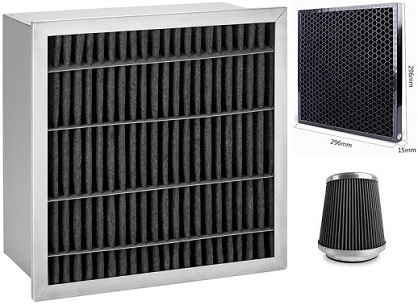A carbon filter (also known as an activated carbon filter) is a type of air filtration device designed to adsorb volatile organic compounds (VOCs), toxic gases, odors, and other airborne pollutants. The primary material used is activated carbon, which has a porous structure and an extremely large surface area for adsorption.

Carbon filters operate based on the principle of physical surface adsorption. When contaminated air passes through the activated carbon layer, pollutant molecules are trapped on its porous surface, resulting in cleaner air flowing through the system.
Activated carbon layer: The core filtering material made from wood, bamboo, coal, coconut shell, etc., through an activation process.
Filter frame: Usually made of galvanized steel, aluminum, or high-durability ABS plastic.
Pre-filter layer (optional): Captures larger dust particles before the air reaches the carbon media.
Panel carbon filter: Used in residential HVAC systems.
Granular or pellet carbon filter: Common in aquariums and small air purifiers.
Carbon cartridge filter: Designed for industrial air filtration systems.
Combined HEPA + carbon filter: Ideal for cleanrooms and hospital environments.
Removing chemical odors in laboratories
Eliminating VOCs in manufacturing plants
Filtering smoke and kitchen odors in restaurants and hotels
Installed in commercial building HVAC systems
Used in household air purifiers
In HVAC systems (Heating, Ventilation, and Air Conditioning), filtering harmful gases like VOCs is essential—especially in cleanrooms, chemical plants, laboratories, and urban residential buildings.
Common VOC sources include:
Paints, adhesives, and solvents
Cleaning agents, perfumes, and cosmetics
Industrial manufacturing processes
These gases not only produce unpleasant odors but also pose serious health risks such as eye irritation, respiratory issues, and long-term toxicity.
Activated carbon filters are integrated into HVAC systems to effectively adsorb VOCs and hazardous odors. The porous structure with a high surface area captures gas molecules, providing cleaner and safer indoor air.
Key benefits of HVAC carbon filters:
High efficiency in removing VOCs, smoke, and chemical fumes
Enhances the durability of HVAC systems
Reduces indoor air pollution risks
Office buildings and shopping malls
Electronic component manufacturing plants
Hospitals, laboratories, and cleanrooms
High-end residences and urban apartments
We specialize in providing high-performance, genuine carbon filters suitable for both residential and industrial air purification needs.
Phone: 093 143 5454
Email: info@congnghelockhi.vn
Website: congnghelockhi.vn
👉 Contact us today to get expert advice on the most suitable carbon filter for your air filtration system!